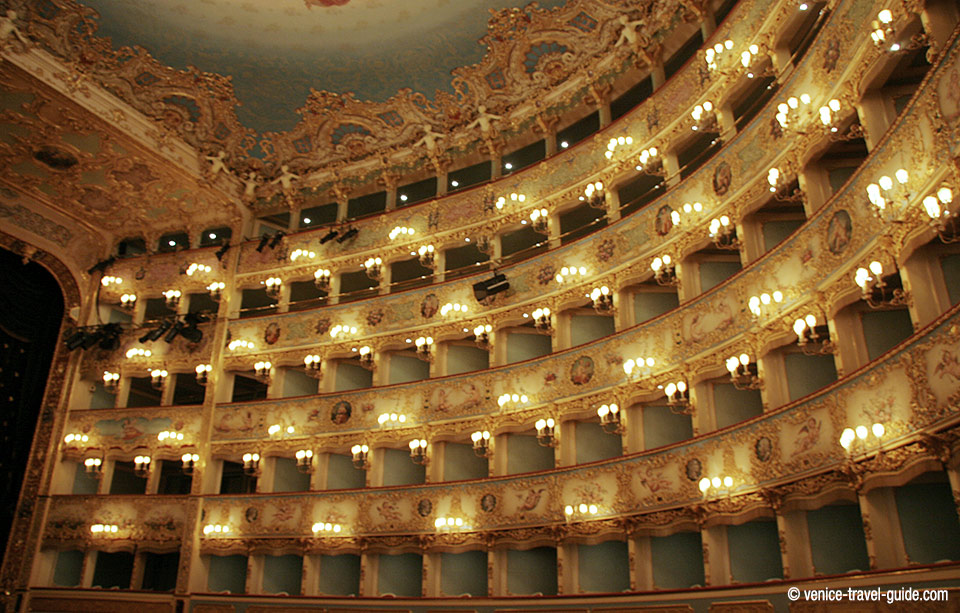Teatro La Fenice is the opera house in Venice. It is one of the most famous theatres in Europe, the site of many famous opera premieres. Its name reflects its role in permitting an opera to "rise from the ashes" despite losing two theatres.
Since opening and being named La Fenice, it has burned and been rebuilt twice more.
First theatre
In 1774, the San Benedetto Theatre, which had been Venice's leading opera house for more than forty years, burned to the ground. No sooner had it been rebuilt than a legal dispute broke out between the company managing it and the owners, the Venier family. The issue was decided in favor of the Veniers. As a result, the theatre company decided to build a new opera house of its own on the Campo San Fantin.
The construction began in June 1790, and by May 1792 the theatre was completed. It was named La Fenice, in reference to the company's survival, first of the fire, then of the loss of its former quarters. La Fenice was inaugurated on May 16, 1792 with an opera by Giovanni Paisiello entitled I Giuochi di Agrigento (libretto by count Alessandro Pepoli).
From the beginning of the 19th century, La Fenice acquired a European reputation. Rossini mounted two major productions in the theatre and Bellini had two operas premiered there. Donizetti, fresh from his triumphs in Milan and Naples, returned to Venice in 1836, after an absence of seventeen years.
Second theatre
In December 1836, disaster struck again when the theatre was destroyed by fire. However, it was quickly rebuilt with a design provided by the architect-engineer team of the brothers, Tommaso and Giovanni Battista Meduna. La Fenice once again rose from its ashes to open its doors on the evening of December 26, 1837.
Giuseppe Verdi's association with La Fenice began in 1844, with a performance of Ernani during the Carnival season. Over the next thirteen years, the premieres of Attila, Rigoletto, La Traviata and Simon Boccanegra took place there.
During the First World War, La Fenice was closed, but reopened to again become the scene of much activity, attracting many of the world's greatest singers and conductors. In 1930, the Venice Biennale initiated the First International Festival of Contemporary Music, which brought such composers as Stravinsky and Britten, and more recently Berio, Nono and Bussotti, to write for La Fenice.
On 29 January 1996, it was completely destroyed by fire. Arson was immediately suspected. In March 2001, a court in Venice found two electricians guilty of setting the fire. Enrico Carella and his cousin, Massimiliano Marchetti, appeared to have set the building ablaze because their company was facing heavy fines over delays in repair work. Carella, the company's owner, disappeared after a final appeal was turned down. He had been sentenced to seven years in prison. Marchetti surrendered to serve a six-year sentence.
Present theatre
After various delays, reconstruction began in earnest in 2001. In 650 days, a team of two hundred plasterers, artists, woodworkers, and other craftsman succeeded in recreating the ambience of the old theatre at a cost of some €90 million.
La Fenice was rebuilt in 19th-century style on the basis of a design by architect Aldo Rossi and using still photographs from the opening scenes of Luchino Visconti's 1954 film Senso, which was filmed in the house, in order to obtain details of its design. It reopened on 14 December 2003 with an inaugural concert of Beethoven, Wagner, and Stravinsky. The first opera production was La traviata in November 2004.
Critical response to the rebuilt La Fenice was mixed. The music critic of the paper Il Tempo, Enrico Cavalotti, was satisfied. He found the colours a bit bright but the sound good and compact. However, for his colleague Dino Villatico of the La Repubblica the acoustics of the new hall lacked resonance and the colours were painfully bright. He found it "kitsch, a fake imitation of the past". He said that "the city should have had the nerve to build a completely new theater; Venice betrayed its innovative past by ignoring it". However, for many Venetians, a painful wound in the historical, much-admired, much adored cityscape has begun to heal.
Theatre Tours
If you are visiting Venice, the Teatro La Fenice is an essential destination to make your stay unique. A tour through the stuccoes and gilded beauty of its prestigious rooms will allow you to discover the backstage area and the secrets of the Theatre and its protagonists, and listen to its history from the origins to the present.
Tours for Groups
Guided Tour conducted by an expert, who will illustrate the history of the Theatre and its reconstruction. This service is available upon reservation in 4 languages: Italian, English, German, French. The visit lasts approximately 45 minutes.
Promenade through the theatre
The promenade through the Theatre is an exclusive service that gives access to the Theatre with an expert guide who will lead the guests to discover the Theatre and its spaces: the Foyer, the Theatre, the Royal Box and the Sale Apollinee. At the end of the visit, the guests will be invited to taste a typical Venetian aperitif in one of the Sale Apollinee. The service is available upon reservation in Italian, English, French and German for a minimum group. The Promenade through the Theatre lasts 1 hour and 15 minutes.
How to get to the Fenice
The Fenice can be easily reached by taking waterbus Line 1, which runs on the Grand Canal and has stops at both the train station and Piazzale Roma (which has both parking facilities and buses). Just get off at the nearby stop of Santa Maria del Giglio. Also well worth seeing near the Fenice are Santa Maria del Giglio Church, San Moisé Church, San Fantin Church and Campo San Maurizio.
La Fenice Program
What's on in La Fenice: www.teatrolafenice.it
Map of Teatro la Fenice
AddressCampo S. Fantin, 1965
30124 Venezia, Italia


